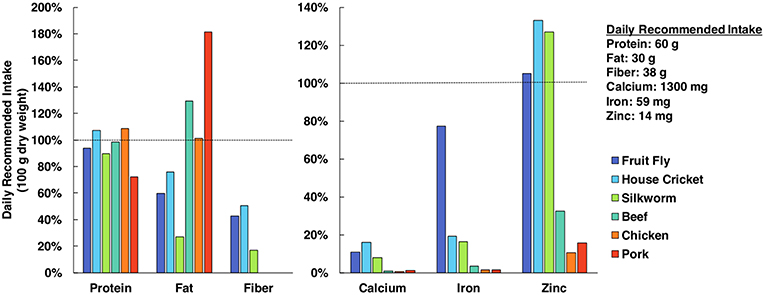Being able to afford to eat meat every day was once a dream for poor people but now it's so common an entire $2 billion environmentalism industry claims meat is killing the planet, despite livestock being a relative pittance in emissions. Given that, you'd think activists would embrace plant-based alternatives but they don't, because plant-based meat alternatives still use science (like genetically engineered yeast.) Potential competitors to Impossible Burger and the Beyond Meat Burger are insect fare, which hasn't really taken off in the U.S., and cell-based meat has been in development for decades.
Given that neither of those last two are viable yet, can a hybrid of the two, laboratory grown insect protein, find success?
Writing in Frontiers in Sustainable Food Systems, the authors lay out some challenges but good luck predicting the free market. In the 1990s, when corporate committees were taking forever to come up with Bluetooth, Wi-Fi filled the gap and had much greater success. When pundits said the war for music listeners would be between Super Audio CD and DVD-Audio the free market went the other way with .mp3s. And neither of those two had environmentalists declaring war on them before they began. The challenge for lab-grown insect meat is that it will be fed on plants and genetically modified for growth, nutrition and flavor. At least as long as environmental trial lawyers get a cultural halo around their efforts to stop progress, lab-grown insect meat may be doomed before it ever reaches the market.
It won't be because of nutrition.

Nutrient profile comparison of edible insects and popular mammalian meats quantified in terms of percent of daily recommended intake (DRI) in a 100 g sample (dry basis). Protein, fat and fiber DRI values are specifically for men <50 years old and weighing 75 kg and mineral DRI values were selected as the greatest value from the respective ranges. Credit: 10.3389/fsufs.2019.00024
Lab grown insect meat does have advantages but are they compelling? Yes, some plant crops require so much water we might as well be growing meat while cultured meat cells take more energy and resources than livestock, those are reasons to adopt insect-based lab meat, but gasoline is still in use 150 years after its introduction while the heavy plow outlived the medieval period for compelling reasons that have nothing to do with corporate conspiracies by Big Plow. It may be that the meat business will continue to optimize and reduce environmental impact and insect-based alternatives remain a gimmick for elites who want something more culturally superior feeling than plant-based burgers.
The issue is not just taste. Both Impossible Foods and Beyond Meat understand the aesthetics of meat and that humans evolved eating it. They are replicating the texture and even behavior (both have equivalents for the juice that flows from meat) in order to be appealing to mainstream consumers. How will lab grown insects behave like a steak?
There's no easy answer but there may not need to be. One thing is certain; surveys are no help because behavior is what counts. Though relatively few people on surveys claim to be anti-vaccine, it turns out they don't identify as that even if they are, so the west coast and pockets of elites in the east may not vaccinate their kids, but they call it being anti-corporate or pro-choice. Unprompted on surveys, the worry about GMOs is in the single digits among consumers, but when prompted about information on labels everyone claims to want to have everything listed - unless it will cost them more money.
It may be that insect products can find a market where texture and such do not matter. Chemistry has produced a great artificial banana flavor, for example, but no one eats an actual artificial banana. So rather than being shaped into a steak, it may be an ingredient, and then the only fight will be with activists over what kind of warning label they will demand on the future.





Comments